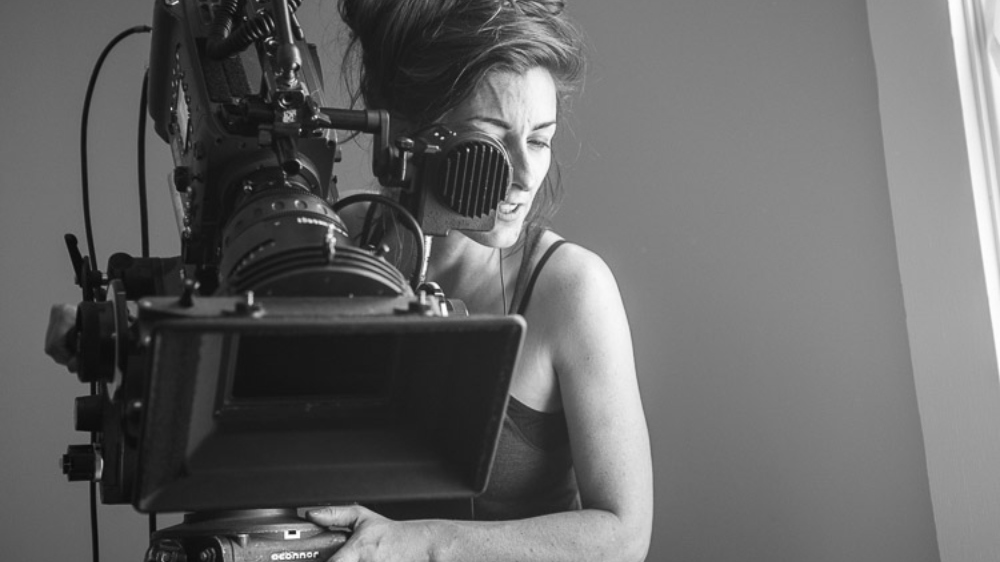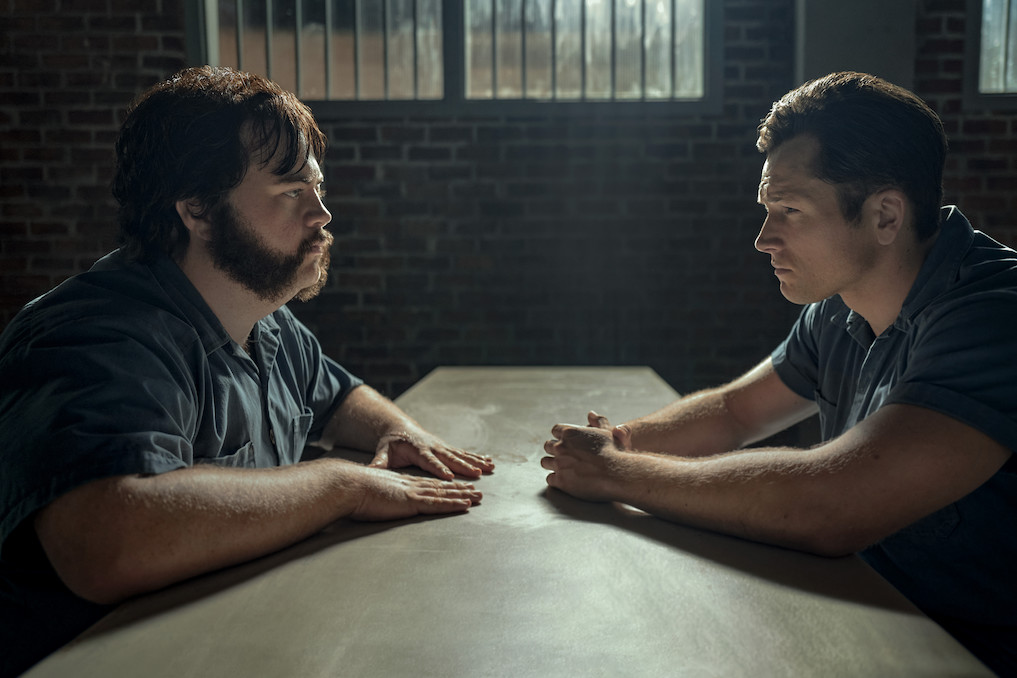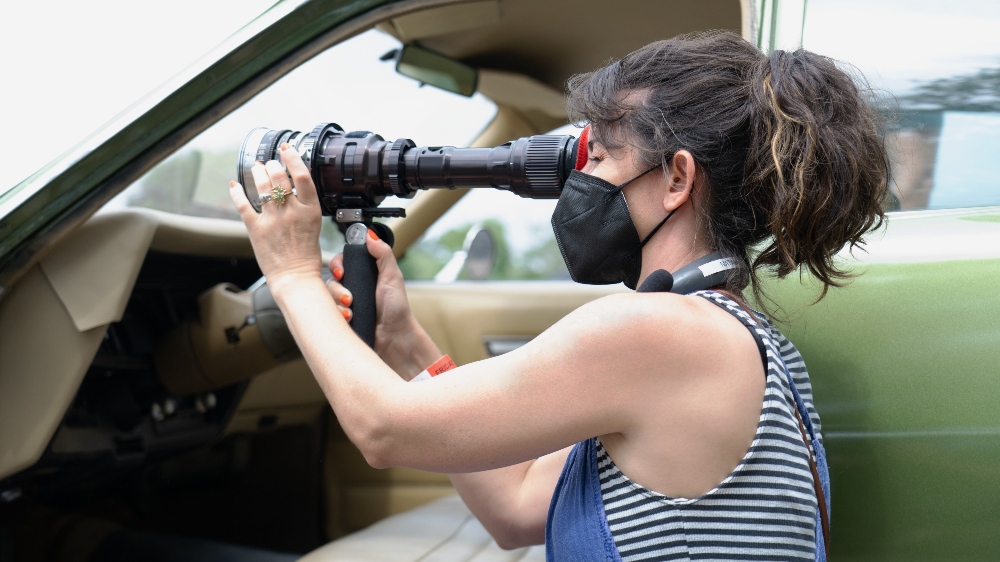
Black Bird was one of the great pieces of television in 2022. Created by Dennis Lehane, known Gone Baby Gone and The Drop, the craftsman told a true story that, even with all its on-screen talents’ gravitas and a score from the band Mogwai, without artifice.
It was pure bleak immersion — a stirring experience that landed cinematographer Natalie Kingston an Emmy nomination for Outstanding Cinematography for a Limited or Anthology Series or Movie.
Black Bird, which is about prisoner Jimmy Keene (Taron Edgerton) trying to get a confession out of serial killer Larry Hall (Paul Walter Hauser), was Kingston’s first television series. Previously, she shot feature films such as Shapeless and the wonderful Wolf of Snow Hollow.
Recently, Kingston took Below-The-Line behind-the-scenes of shooting the miniseries.
Below-The-Line: What colors did you really want to emphasize with Black Bird? Which colors did you want to create discomfort?
Natalie Kingston: Well, my first inspiration was this Gordon Park series called The Atmosphere of Crime, and it was this series he did in the 1950s. He photographed different prisons around the US for six weeks, and one of the first things that jumped out was the palette of these prisons were very pastel, like light pinks and seafoam greens and light blues. It was the opposite of what you would expect in prisons, I guess. You think of a prison and it seems very steely gray and white, and there is a lot of that, but I thought this pastel color palette was really unique.
I did some research and came to find out, early on, the warden’s thought that using these pastel colors, like light pink, was a calming effect on male prisoners. So, that was the theory behind it. We kind of took that and ran with it, and the production designer, Charisse [Cardenas], and I really collaborated closely on finding the perfect shades of those pastel colors and painted our prison and that palette. But there are different palettes going on that’s the prison world, and then you have this very warm palette in the detective world of Brian Miller (Greg Kinnear), specifically, and Lauren McCauley (Sepideh Moafi). And so, the idea was to contrast those.
BTL: Those days when you’re dealing with exteriors, was it a nice sigh of relief?
Kingston: Yeah, yeah, exactly. We spent so much time in the cells, and as you may know, it is a real present location. It got small and claustrophobic and very mundane.
BTL: For you, how’d you interpret the core of the story when you first read it?
Kingston: I mean, at the end of the day, it is a character study, and it wasn’t about being overly theatrical with Larry Hall’s killings or putting the idea of a serial killer on a pedestal and making that feel heightened in any way with the visuals or the tone of it all. This is a human story, and it was an examination of all of these men in this story, specifically Jimmy and Larry, and what degrees or what point in the spectrum do they lie on toxic masculinity and misogyny.
It was really just an examination on that relationship of Jimmy and Larry and how Jimmy pretty much comes full circle at the end. And really, you start to see a lot of parallels within Jimmy and Larry, although Jimmy’s not a serial killer, and Larry is, but he does have some of the same instincts that Larry does at times.
What also drew me into it was it wasn’t so black and white. Larry is evil, and Brian Miller is good… It was a lot more complex than that, and it was just really kind of sinking into that gray area; it just wasn’t so good versus bad. At times, within these very uncomfortable conversations, you kind of see the humanity in Larry Hall, and you’re not condoning him and what he has done, but you’re seeing that he still is a human being and he’s not someone who just is a bad person and who’s done some horrible things, but still at the core of it, he’s a human being just like everyone else on the show. I just thought that was really just compelling and complex.

BTL: How’d you want to visualize, as you said, those shades of grey?
Kingston: It was really just kind of getting out of the way a lot of the time. Not doing anything special per se, but really just creating a feeling of being immersed in those cell blocks in the cells with Jimmy and Larry. A lot of times it was practicing restraint and not moving the camera and sinking in with these characters and being able to really feel immersed within their reactions.
Especially with Jimmy, just having to really swallow how he really feels and how he really wants to react to what he’s hearing with the stories Larry’s telling him that are just sick and insane and horrible, just sinking in there with him. I didn’t have to do much at times with the camera. When we moved the camera, it was intentional. It really meant something.
BTL: So, you have your vision from the beginning, but how’d the performances begin to affect the choices you were making?
Kingston: That happens with every project. You have a strong idea of how you want to tell the story visually. You come up with a visual language, and within that language you can still pivot and you can go into the day with a plan and you might throw it out the window because of what the actors might bring to the scene, or maybe they’re blocking it in a different way than you had planned.
Going into a project with a very prepared and with a good solid plan gives you that confidence to pivot. When you have something that’s going to work, it allows you to be open to discover things that may be a lot better than what you thought.
BTL: Any extreme pivots you made?
Kingston: Well, a lot of that we had to pivot a lot because we shot this in New Orleans and during the summer, and so weather was not on our side a lot because it rains almost every single day in Louisiana. I remember a few day exteriors where we had to stop for hours in the middle of the day just for lightning, and we just couldn’t do anything, and we had to pick things back up towards the end of the day, and it had to match what we shot at the beginning of the day. So that didn’t go as planned, but you just do your best to try to make it match. Or in some cases, we combined shots into one, whereas maybe three shots became a single shot, stuff like that.
BTL: A part of the story takes place in Illinois. How did you feel the light in New Orleans compared to Illinois? How did you want to manipulate the light in New Orleans to make it feel more like Illinois?
Kingston: It was also supposed to be Indiana as well. The Springfield prison was in Springfield, Missouri. So, Illinois was really just in the beginning where Jimmy lived. That was a lot of interiors, and Indiana was Brian Miller, the detective world, and much of that was in offices that took place during the day. I didn’t really do anything to make the light feel different per se.
One big thing we did differently was, or to make it feel like not Louisiana, we had a few scenes in cornfields, and Larry Hall’s victim, Jessica Roach, he killed her in a cornfield when she was riding her bike. There are no cornfields in Louisiana, so we shot in sugarcane fields and the art department basically planted acres of corn that were flown in. We basically converted existing sugarcane fields into corn fields. But as far as lighting, I didn’t really have to manipulate it to make it feel like a different place. It was really what we put in front of the camera production design wise or setting atmospheric wise.
BTL: Have you shot in New Orleans before?
Kingston: I’m actually from there. I grew up in South Louisiana, a small town. I lived in New Orleans for a long time, so yes, I’m very familiar with it.
BTL: In that case, what is the best way to photograph Louisiana then?
Kingston: Don’t shoot in the summer. It’s raining every day, and there’s hurricane season. I mean, it depends. It really depends where your story takes place. I love Louisiana in the wintertime. I love Louisiana Winter light. It’s low lying, it’s beautiful. The color palette is very wyeth. It’s a lot of browns and the sky’s really blue and there’s very little green, but it’s stunning. I personally think that’s the best time of year to shoot. But yeah, of course it depends. Our story really didn’t call for that.
BTL: The story did call for repetition and mundanity. How’d you want to lean into that rather than run from that as a cinematographer?
Kingston: Yeah, I think mundane is a big part of just being in prison. A lot of it is very repetitive visually, just inherently. Something that I wanted to do very subtly is as the series progressed, I wanted to create, in a very subtle way, a slightly darker feeling within the prison as Jimmy starts to really confront his own demons and as he draws closer to Larry and as we hear just darker and creepier stories from Larry Hall. So that’s something that I tried to do in a very subtle way within Springfield Prison because you feel a bit more contrast. But still, I didn’t want it to feel overly theatrical, and I still always wanted the lighting and color to feel really grounded in naturalism and still feel gritty and not so flashy because it’s still a human story.

BTL: For you, in that restraint of yours, what are those subtle choices you think have a major impact on an audience?
Kingston: Jimmy is transferred to Springfield Prison at the end of episode two, but episode three, he starts to really experience prisons. His first week there, he meets Larry for the first time and he’s trying to become his friend without blowing his cover. But also the clock is ticking for him to get out and for him to come to the FBI with the locations of where the victims are buried.
There’s this scene in the TV room right outside of Mess Hall where Jimmy really wants to prove himself to Larry that he could be his friend and he could stick up for him. They’re all watching Make America’s Most Wanted, that’s their show in the TV room and Larry and his friends. And so, Jimmy joins in and all of a sudden this other prisoner randomly comes in and changes the channel and upsets them.
Jimmy gets up and fights the guy, basically beats the shit out of him. We didn’t really do anything fancy with the camera and leading up to that fight. It’s pretty quiet in the scene, and it’s just Jimmy looking at this guy and looking at Larry and should he do this, should he not? Is it too much? The camera’s just in Jimmy’s perspective the entire time, and it’s pretty static.
There’s a couple tracking shots that are motivated just from Jimmy entering the scene and the other prisoner entering. But the idea was really to build that tension through just the static camera. Then in the fight we’re in a low angle and Jimmy just punches the shit out of the prisoner in a higher angle, and then the camera rushes out as the energy ramps up as the guards haul out Jimmy and throw him in the hole in solitary confinement.
And then at the end of that, we just have a really, within his cell and solitary confinement, it’s a really slow push in as he’s reflecting on what he just did and probably thinking, “Was that the right thing to do? Was it too much?”
I think that’s a good example of not having to do much with the camera and the lighting is still very natural. It’s supposed to be the end of the day towards sunset, and this was all on a stage, so we created that feeling with the lighting, but still kept it very dark and moody.
BTL: To create that static effect, even when you shot on two cameras, you wanted to make it feel like one. How’d you pull that off?
Kingston: Yeah, because it’s always intentional with whose perspective that we’re in. It’s never using that second camera just to spray the room with coverage. It’s like, okay, if a camera’s here, then does B camera have a shot? Okay. If not, then it stands down and we’re not going to force a shot just to have quantity over quality. And then if there isn’t an angle for B camera, then yeah, whose perspective are we in and what does it say?
It’s also having that integrity about lensing, not just throwing on a longer lens just to be able to just pick off a shot. We were very intentional about staying on the wider end of the spectrum and focal lens. I really lived around 35, 40 mil, and that was again, just to feel you’re in those subjective perspectives of Jimmy and Larry and the other characters. It wasn’t about breaking that and going on longer just to be able to pick off a shot.
BTL: You shot all six episodes. As a cinematographer, since this isn’t always the case on a limited series, how gratifying was it visualizing a story this vast from beginning to end?
Kingston: Well, it was also my first TV series, so I thought it was a really wonderful opportunity that I felt I was ready for. To be able to have the trust from Dennis and the rest of the team, for me to be able to establish this look, create this look and maintain it throughout the series, it was just incredible. To have my hand across the whole series and see it pay off in a really well-received TV show, I’m really proud of that. And then to get nominated for it, it was just a really good confirmation.
The Emmy-nominated Black Bird is now available to stream on Apple TV+.





